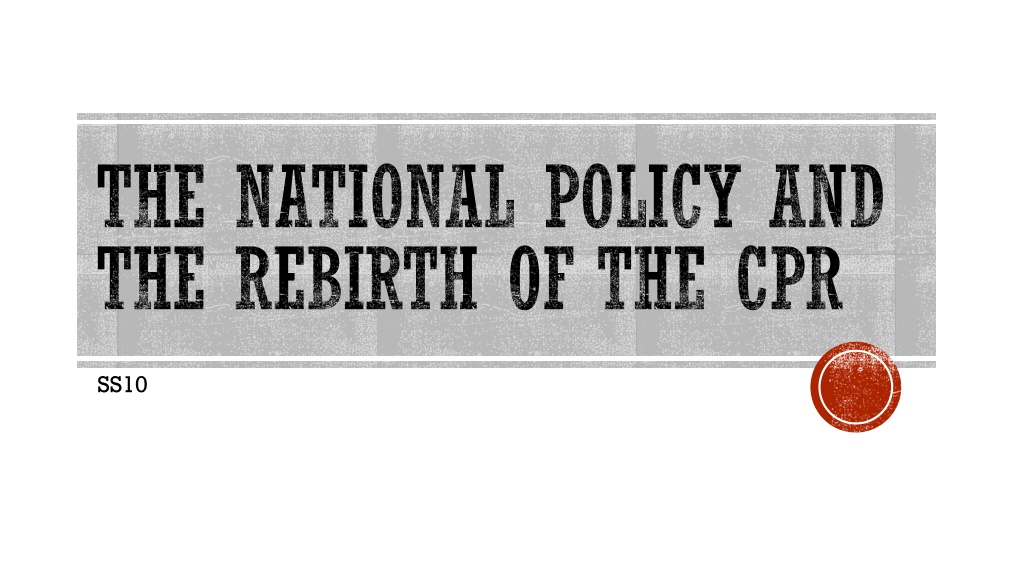Canadian Railways: National Policy and Economic Strategies
The historical narrative delves into the contrasting opinions of Alexander Mackenzie and John A. MacDonald on the Canadian Pacific Railway (CPR), emphasizing Mackenzie's reluctance due to economic concerns and MacDonald's resurgence with the National Policy. It explores how political decisions, such as protective tariffs and westward expansion, shaped Canada's economic landscape during the late 19th century, influencing trade dynamics and national development.
Download Presentation

Please find below an Image/Link to download the presentation.
The content on the website is provided AS IS for your information and personal use only. It may not be sold, licensed, or shared on other websites without obtaining consent from the author. Download presentation by click this link. If you encounter any issues during the download, it is possible that the publisher has removed the file from their server.
E N D
Presentation Transcript
THE NATIONAL POLICY AND THE REBIRTH OF THE CPR SS10
MACKENZIE AND THE CPR What was Alexander Mackenzie s opinion on the CPR? Unlike John A. MacDonald, Alexander Mackenzie did not believe that Canada needed a transcontinental railway He thought it was simply too expensive to build because just before Mackenzie was elected, an economic depression Thus, construction of the CPR stopped while he was prime minister However, he did allow surveyors to continue investigating possible routes that a potential railway could take In British Columbia, this caused outrage across the new province; they had been promised the CPR as one of the conditions of joining confederation in 1871
MACDONALD MAKES HIS COMEBACK During the late 1870s, Macdonald s Conservative Party began to recover in popularity Mackenzie and the Liberal Party became associated with the economic depression that had swept the country Although many of the problems, such as crop failures and plagues of insects, were not directly their fault, they were still blamed for the problems In response to this, MacDonald developed what he called his National Policy It was both his election platform and his vision for the future of Canada The National Policy was based on three main ideas, a system of protective tariffs, settling the west, and finishing the CPR
THE TARIFF SYSTEM During the 1870s, American companies and farms could produce goods and agriculture much faster and cheaper that their Canadian counterparts Many of these companies would sell their products in Canada, and Canadian companies simply couldn t match their prices without going out of business In response to this, MacDonald promised to double the tariffs, or taxes, that American companies would have to pay to sell their goods in Canada What effect do you think this would have on American-made products sold in Canada? The idea was to make American goods too expensive to be sold in Canada, so people would buy from Canadians instead
WESTERN SETTLEMENT To provide a larger market for Canadian goods, MacDonald wanted to settle the vast, sparsely populated west by farmers MacDonald s plan was for these farmers to produce grain to be exported around the world, particularly to Europe Then, the farmers would spend their money on Canadian- made goods produced in eastern Canada The idea was that the east and west would have a symbiotic relationship, neither competing with each other but supporting each other instead
FINISHING THE CPR In MacDonald s view, all of this depended on the CPR finally being finished He believed it was pointless to develop western agriculture if they could not be sent to ports on the east coast quickly for export, or if goods built in eastern Canada could not be transported to the west to be sold These promises succeeded in convincing many voters that Macdonald deserved a second chance, and in 1878 he was re- elected as prime minister with a large majority
THE CPR SYNDICATE But because of the Pacific Scandal, Hugh Allan was no longer involved, meaning that new investors had to be found Macdonald eventually found three new investors; the George Stephen, president of the Bank of Montreal, Donald Smith, governor of the HBC, and James Hill, a Canadian investor in American railways This group would come to be called the CPR syndicate Macdonald offered them a monopoly on all railway traffic west of Lake Superior for the next 20 years In return, they agreed to complete the CPR within 10 years
THE CPR ROUTE CHANGE The blue line represents the CPR route as originally planned The red line represents the CPR s actual route
VAN HORNE AND THE CPR Construction started on the CPR in 1881, but proceeded very slowly At the going rate, it would not completed in 10 years To help, the syndicate then hired William Van Horne to as the project s new general manager to help finish it He made the project extremely efficient; he increased the construction speed from 230 km a year to over 800 km a year But as the project reached the Rocky Mountains, it began to run out of money The government paid money to the CPR based on every section completed and because construction through the Rockies was slow and dangerous, making money scarce By late 1884, it looked like the CPR might simply run out of cash What event that happens around this time do you think might affect this?
THE CPR SAVES CANADA In March of 1885, the Northwest Rebellion breaks out, meaning the government needed to send soldiers to the Northwest Territories as fast as possible While the CPR was not finished, it allowed troops to be sent from Ontario to Manitoba in just five days This demonstrated to the public that the CPR would allow the government to respond to problems quickly Thus, the syndicate could ask Macdonald for enough money to finish the CPR without looking foolish Macdonald agreed to one final cash delivery to help finish the railroad, which it does in the fall of 1885























